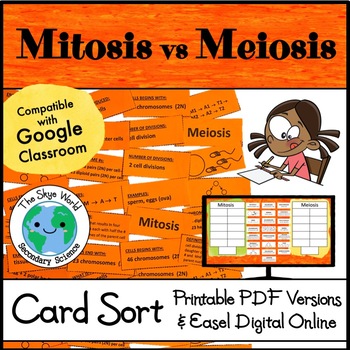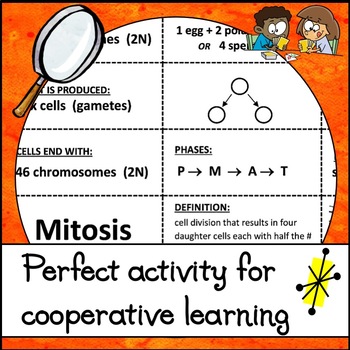Card Sort Activity - Mitosis vs Meiosis with Digital Easel Version Online
- PDF
- Internet Activities
- Easel Activity
What educators are saying
Also included in
- This bundle of activities on cell division includes notes, worksheets, card sorts, labs, and more covering the cell cycle, mitosis, meiosis, specialization, and chromosomes. By completing these activities, 9th and 10th grade biology students will learn how to go through the steps of mitosis and meioPrice $22.00Original Price $33.00Save $11.00
- In this mini-bundle, students will describe and compare the steps of the cell cycle, mitosis, and meiosis. Other topics include gametogenesis, cell differentiation, and chromosomes. After completion, students should be ready to take a test or quiz over cell division.Important InformationAnswer key iPrice $6.00Original Price $9.00Save $3.00
- This growing bundle of lessons for 9th and 10th grade biology includes the metric system, biochemistry, cells, photosynthesis, respiration, cell division, heredity, and classical genetics. Bundles include notes, worksheets, lab activities, card sorts, task cards, digital Boom cards, review sheets,Price $191.00Original Price $317.00Save $126.00
Description
This card sort on mitosis and meiosis will prepare your 9th and 10th grade biology students to compare and identify the differences and similarities in haploid and diploid chromosome numbers, cell structures, resulting cells, and the steps of each process. A digital Easel activity, cut & paste version, instructions, and interactive notebook chart are also included.
Important Information
- includes digital Easel version online that is compatible with Google Classroom
- detailed instruction and suggestion guide included
- Answer key and student chart for interactive notebook included
- Recommended for 9th and 10th grade biology
How it Works
- Students will sort a deck of cards into groups.
- Students will fill in a chart with the information after you go over the answer.
- Walk around and monitor student progress to check for understanding.
- Have students keep the chart out so you can record this as a daily grade.
TEKS Covered
B.4B
B.5A
B.6G
NGSS Standards Covered
HS-LS1-4
HS-LS3-2
Materials Needed
Card stock (white or light colors), scissors, rubber bands
Also found in these money saving bundles
- Bundle of Lessons – Cell Division
- Cell Division Mini-Bundle - Mitosis & Meiosis Card Sort, Task Cards, Worksheet
- 9th and 10th Grade Biology Growing Bundle of Lessons
Related Resources
- Lab Activity – Why Are Cells So Small?
- Review – Cell Division Worksheet
- The Cell Cycle and Mitosis Task Cards – Interactive Online Boom Cards Activity
Acknowledgements
Thank you to the following artists for the wonderful clipart used throughout this unit. Just click on their shop name to go directly to their stores: Ron Leishman’s Digital Toonage - Sarah Pecorina Illustration - Clipartino - A Sketchy Guy - Glitter Meets Glue - The Cher Room - Krista Wallden Creative Clips - PGP Graphics
Terms of Use – copyright ©Catherine Skye All rights to this product are reserved by author. This authorizes one teacher to use this product. If you want to share it with other teachers, please purchase a license to share this work. Copying by more than one teacher, classroom, department, school, or school system is prohibited UNLESS you purchase a license. Clipart and elements found in this PDF and others on my site are from the public domain unless otherwise noted. All products on my site are intended for classroom and personal use and may not be digitally copied for reuse in any form. Any misuse is considered copyright infringement and violates the DMCA (Digital Millennium Copyright Act).









